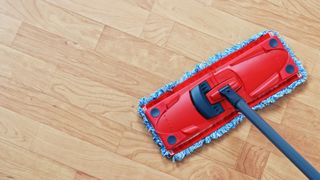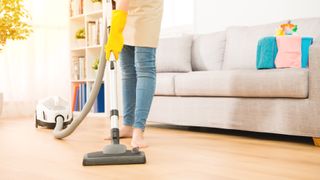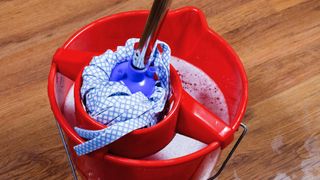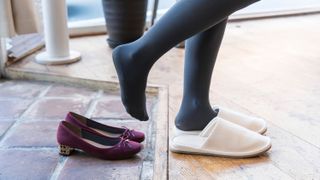How to clean hardwood floors without damaging them
Here’s how to clean hardwood floors the right way

If someone were to ask you how to clean hardwood floors, you would picture a mop and bucket, right?
Actually, there’s a lot more to it than that. Depending on your floor type and finish, the best products and techniques will vary. For instance, you might have one of the best vacuum cleaners, but that vacuum cleaner could actually be scratching your floors.
Don’t worry: Here we will take you through the best method to clean your hardwood floors, step-by-step. So you don’t need to worry about causing damage as you clean — plus, you can expect streak-free results. Here’s how to clean hardwood floors.
If you have scratches on your floor, be sure to check out our guide on how to fix scratched wood floors to make them look like new. Plus, here are 7 mopping mistakes which are ruining your floor.
- Here's how to install laminate flooring without calling a builder
- Check out how to get rid of dust mites quickly in 7 simple steps
How to clean hardwood floors
Microfiber mop or broom
Vacuum cleaner
Hard floor cleaning solution
Wood floor polish or floor wax (optional)
1. First, pick everything up off the floor and move any obstacles out of the way, such as chairs. It’s a good idea to check that no one is going to need access to the space before you clean it, too — the last thing you want is pawprints dried into the finish!
2. Next, pick up any immediate dust using a microfiber mop such as the Turbo Microfiber Mop Floor Cleaning System ($39.95, Amazon) or a dustpan and broom. Work your way around the entire floor, being sure to reach under furniture and into the corners. This is all you need to do for light everyday cleaning.
3. If you’ve got heavier debris scattered around, such as crumbs and dry mud, then it’s time to break out the vacuum cleaner. Before you jump the gun, make sure you use the hard floor setting, or raise the brush bar manually — this will stop it from potentially scratching your floors.
Sign up to get the BEST of Tom’s Guide direct to your inbox.
Upgrade your life with a daily dose of the biggest tech news, lifestyle hacks and our curated analysis. Be the first to know about cutting-edge gadgets and the hottest deals.
It’s also worth checking out the wheels on your vacuum cleaner; plastic can scratch, while if they’re rubberized they will be kinder to your floors. You could alternatively use one of the best robot vacuums to save you the time and effort of this step.

4. Now that your floors are clear of debris, next come the mop and bucket. Once again, a microfiber head design is recommended. You will need to use a hard-floor cleaning solution — follow your flooring manufacturer’s instructions about which brand of cleaner to use.
Water alone can damage certain hardwood floors as it can swell and discolor the wood, so resist this urge. The mop head should only be damp, not sopping wet, and be prepared to rinse it regularly. Avoid leaving standing water on the floor, especially if it’s prefinished wood.
If you want an easy way to apply the hard-floor cleaning solution, some flat mops come with built-in dispensers, such as the Bona Hardwood Floor Premium Spray Mop ($37, Amazon).
Do not use a steam cleaner unless your flooring manufacturer advises it as these can damage hardwood floors. You should also be cautious around electric vacuum mops as most are only suitable on sealed floors — again, check with your flooring manufacturer for guidance.
If you want to use a natural cleaner, such as vinegar combined with water, you should also test this on an inconspicuous area first, as vinegar can dull and damage the surface.

5. Section off each space as you mop so you don’t miss any areas, and consider where you will be left standing once you’ve finished cleaning — you don’t want to corner yourself and end up walking over your freshly cleaned floor.
6. Now you want to help the floor dry as quickly as possible. You have a few options here: You can leave windows and doors open to ventilate the room, you can turn on the ceiling fans, or you can go over the floor with a fresh and dry microfiber cloth.
7. If you want to go the whole nine yards, you can also apply wood floor polish or floor wax once the floor is dry to better seal and protect it in the future. This also adds a nice shine.
Bear in mind that you should only do this every few years, or as often as the manufacturer recommends. You also shouldn’t wax laminate-wood floors or engineered hardwood. Check with your manufacturer if you’re unsure. We recommend the Rejuvenate Professional Wood Floor Restorer and Polish ($21, Amazon).
How often should you clean hardwood floors?
You should give the floors a quick dust or a sweep as often as possible — if it’s a high-traffic area, dust at least a couple of times a week. Vacuuming your hardwood floors is recommended weekly. It’s important to keep up this routine as rogue stones that are carried in by shoes and pets can easily scratch the floor.
We recommend mopping your hardwood floors as often as necessary, although every three to four weeks is best practice. You need to wax or finish your floors much less frequently; this only needs to be done every few years.
Tips to keep your hardwood floors clean and undamaged

- Remove shoes — It sounds like common sense, but make sure shoes are taken off at the door. Placing a mat on the inside of your door can also help to collect any debris that makes it through.
- Don’t use the brush bar — Make sure your vacuum is set to hard floor cleaning and the brush bar is raised. This is to prevent it from scratching your floor as it vacuums.
- Protect your floor — Invest in rugs and protective pads to go under your furniture legs. That way you won’t end up leaving scratches when you move the furniture.
- Pick up a spill as quickly as possible — Don’t leave a fresh stain to set on your hardwood floors, this will only make it more difficult to remove later.
- Keep up your cleaning routine — If you don’t already, get into the habit of cleaning and maintaining your hardwood floors. They will last longer and look better for it.

Katie looks after everything homes-related, from kitchen appliances to gardening tools. She also covers smart home products too, so is the best point of contact for any household advice! She has tested and reviewed appliances for over 6 years, so she knows what to look for when finding the best. Her favorite thing to test has to be air purifiers, as the information provided and the difference between performances is extensive.
